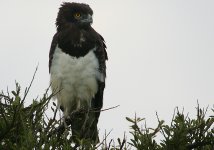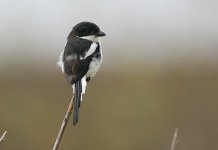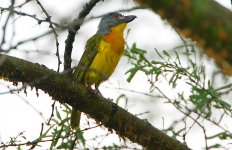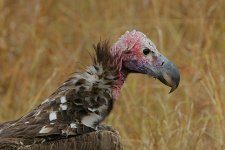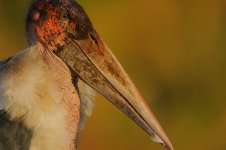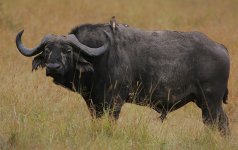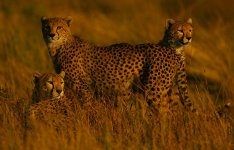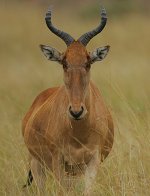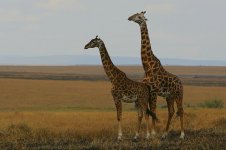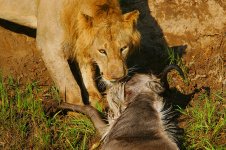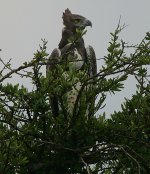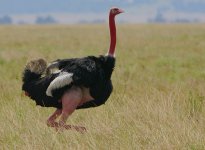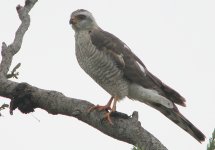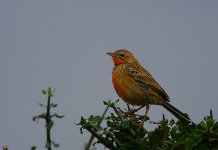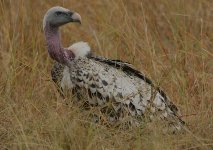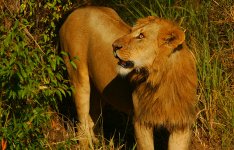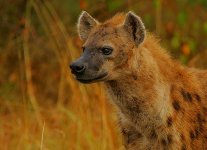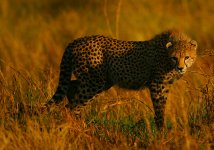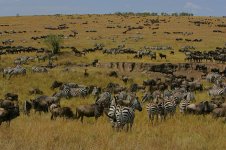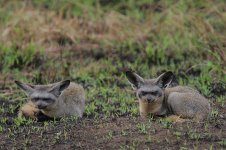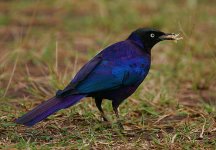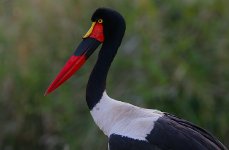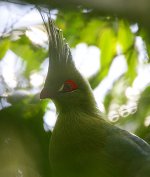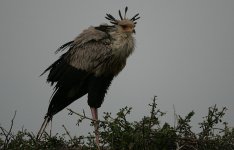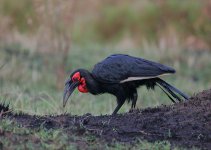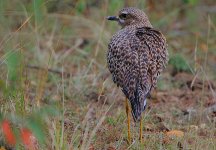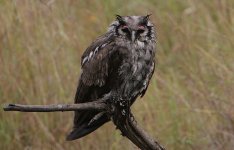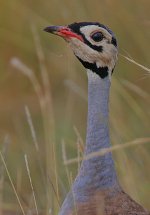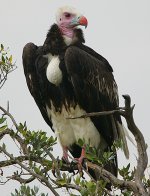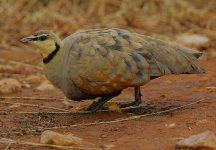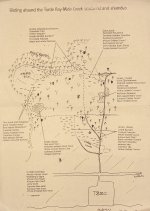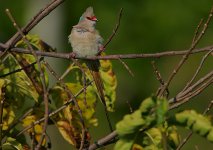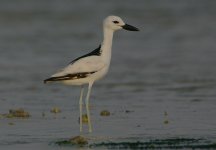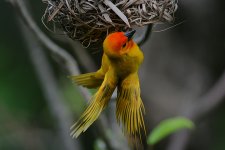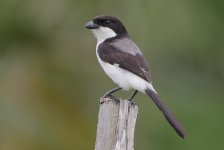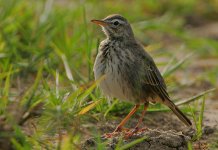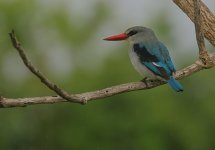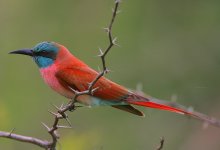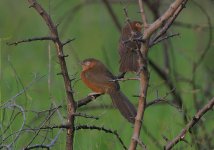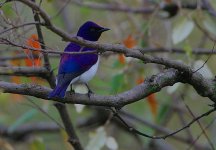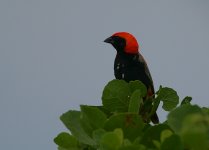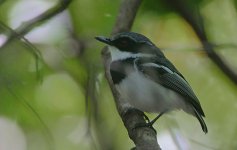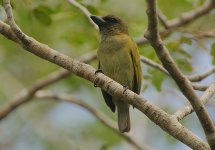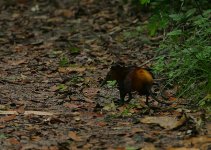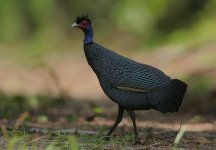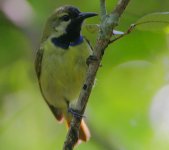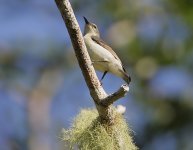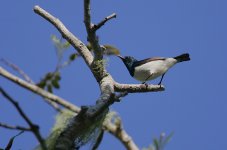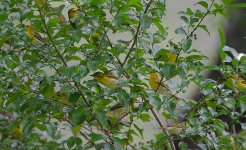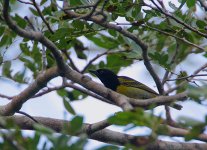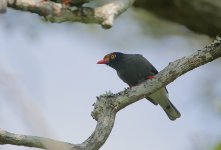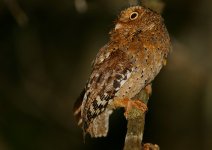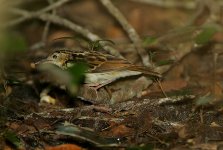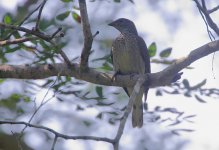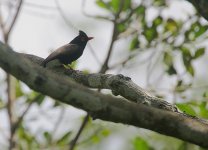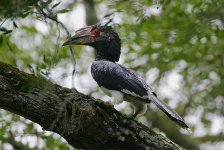Steve G
RAINBIRDER
Whilst undoubtedly this is yet another report written by a Dude about his summer holiday I implore all birders –serious and casual alike to read on as the place of which I write has some real hidden gems and might just offer the answer to that perennial problem of where can one go on holiday for good birds yet keep the spouse/family/girlfriend/boyfriend happy. 
PART 1
I was planning to write a trip report based upon our recent (July 2010) family holiday to Kenya. However this was not our first visit to that country as in 2007 we spent a two-week summer vacation in Kenya which was enjoyable and, from a birding perspective very successful. It therefore seems sensible to write first of our experience in 2007 as it may be of some interest to others contemplating a package holiday deal to coastal Kenya or for those more serious birders in pursuit of some of the Kenyan coastal specialties.
We travelled to Kenya in late July/early-August 2007 by a package holiday deal, initially choosing this venue as it was something different from the typical Mediterranean family holidays that we had been on previously. I had read on the internet that birding was good around the Watamu area and discovered that one of the hotels at Watamu made mention of local bird-watching trips on their website. That same hotel also had an excellent kids club as well as an on-site dive centre (my son is into diving) so we decided to take the plunge and booked a two-week all-inclusive package deal at the Turtle Bay Beach Club through First Choice holidays. The package included two double rooms, return flights from Gatwick to Mombasa, transfers and all food and drink. Unfortunately I have no record of exact costs but the whole package was surprisingly inexpensive (there were four of us: my wife, myself, my 10 year-old daughter and 14 year-old son)!
Having made the booking we were repeatedly asked by friends & relatives why we weren’t going on safari. To be honest we had never given any serious thought to a safari having assumed that it would be too expensive; but as a result of having to field the same query again and again I looked into the possibility of spending some time in one of the Game Parks. Unfortunately our package deal with First Choice could not be changed and our only option was a limited road safari booked directly through our hotel, or to arrange a short safari through a third party. Having finally decided we would like to do a short safari I came across a company called Mombasa Air Safari ( http://www.mombasaairsafari.com/ ) and following some feverish Email activity they came up with a very tempting package comprising of 4 days/3 nights in the Masai-Mara. It wasn’t however a cheap package as July/August is peak season in the Mara due to the Wildebeest migration.
After great deliberation (and spurred on by a welcome but unexpected tax rebate) we decided to book the safari package which included road transfer from our hotel to Malindi airport, return flights to the Mara from Malindi, full board for three nights in two luxury tents in the Mara Intrepids camp and three game drives per day. This cost us around $4,500 ( =£2,200; in 2007 the pound: dollar exchange rate was very favourable) and in addition I was able to negotiate sole use of a safari vehicle/driver for our stay. We were in fact very fortunate as normally the Mara Intrepids camp is fully booked many months in advance of the Wildebeeste migration but as the camp’s airstrip was being re-surfaced they had taken fewer advanced bookings and a few tents were still available. This proved a godsend as we had to fly into & out of Musiara airstrip (-where the Marsh pride hang out for those that follow Big Cat Diaries), then drive to the Intrepids camp through part of the Mara so that our safari package effectively included an extra safari trip at the start and end of our stay (we saw lions and cheetah even before we checked-in to the lodge!).
In advance of our trip I purchased Kenyan visas through a company based in London. With hindsight this was a big mistake as it cost us over twice as much as it would had we bought our visas on entry to Kenya. We had assumed that obtaining visas in advance would save us time at the airport but in fact we were part of a group transfer to the hotel and so had to wait for the rest of the group to purchase their visas on arrival!
We arranged our Mara safari to begin on our fourth day in Kenya and spent the first few days chilling out in the Turtle Bay Beach Club (TBBC). The TBBC whilst not of the very highest quality was certainly very comfortable with a nice beach, good food, excellent staff and lots to keep the kids occupied. Over the first few days I birded the beach, the gardens and the land opposite the TBBC (using a small birding map produced by the hotel) seeing Osprey, Black Kite, Roseate Tern, Red-eyed Dove, African Palm Swift, Blue-naped Mousebird, Red-fronted Tinkerbird, African Pied Wagtail, Zanzibar Sombre Greenbul, Common Bulbul, White-browed Robin-chat, Common Drongo, Violet-backed Starling, Collared Sunbird, Grey-headed Sparrow, Golden Palm Weaver, Bronze Mannikin and Yellow-fronted Canary.
On our third day we left the hotel at 07:45 am & drove (45 mins) to Malindi airport where we boarded a small turbo-prop aircraft for the 90 minute flight to the Mara. We flew past the snow-capped peak of Kilimanjaro crossing the Rift valley to reach the grassy plains of the Mara and the Musiara airstrip before being picked up by our safari jeep. Our drive to the Mara Intrepids camp was our first Safari experience and we were not disappointed. By the time we arrived at the camp we had seen lions, cheetah, elephants, giraffe, buffalo, zebras, warthog, Impala, Thomson’s and Grant’s gazelle, topi and wildebeest.
The Mara Intrepids camp comprises of a reception area, bar, open-plan restaurant and a number of luxury safari tents. The tents are a revelation being set on hardwood floors and containing permanent fixtures and furniture more at home in a quality hotel. All the tents are en-suite with 240volt AC power sockets, modern hot showers/flush toilets and all have verandas with a view. The camp itself sits in extensive wooded grounds bordered by the Talek river and “protected” by a surrounding electrified fence. The complex also has a swimming pool and a shop as well as internet access.
Birding within the camp was very productive with numerous birds frequenting the riverside forest. I saw Schalow’s Turaco, Speckled and Blue-naped Mousebirds, Grey Hornbill, Red-fronted Tinkerbird, Spot-flanked Barbet, Golden-tailed Woodpecker, Lesser Striped Swallow, White-headed Saw-wing, White-browed Robin-chat, Northern Black Flycatcher, Chin-spot Batis, African Paradise Flycatcher, Arrow-marked Babbler, Marico Sunbird, Common Fiscal, Tropical Boubou, Slate-coloured Boubou, Black-backed Puffback, Grey-headed Bush-Shrike, Fork-tailed Drongo, Black-headed Oriole and various starlings (Violet-backed, Superb, Hildebrandt’s and Ruppell’s Long-tailed). As most of the time we were out on safari I didn’t get a chance to explore the full birding potential of the camp.
On our first full day we did pre-breakfast, post-breakfast and afternoon game drives. The following day we left after breakfast taking a picnic lunch and were out in the Mara for the entire day, whilst on day three we repeated the format of our first full day. On our fourth day we did an early post-breakfast safari before checking out and driving back to the airstrip. Having a vehicle/driver to ourselves meant that we could dictate where we went and at what pace. It also allowed me to stop for any interesting birds without hindrance!
All in all our safari experience was fantastic. We didn’t see leopard or Black Rhino but otherwise we saw the full selection of antelope and supporting cast. We had numerous lion sightings and watched two successful hunts (one from a “ringside seat” –which upset my 10 year old daughter). We saw a number of different cheetahs including two brothers, a lone male and three different family groups. We also witnessed the huge numbers of Wildebeest and Zebra that move in to the Mara after the long rains and whilst we didn’t get the chance to see a Mara river crossing (the Mara Triangle is the best placed area to see such crossings) we did experience the spectacle of the “Superherd”. Though primarily a trip to see large mammals we also saw a great selection of birds. Highlights included Saddle-billed and Marabou Storks, Secretary Bird, Bateleur, Tawny Eagle, Martial Eagle, Black-chested Snake Eagle, Ovambo Sparrowhawk, Hooded, White-headed, Lappet-faced and White-backed Vultures, Ruppell’s Griffon, White-bellied and Black-bellied Bustards, various grassland Lapwings and Spotted Thick-knee, Yellow-throated Sandgrouse, Black Coucal, Verreaux’s Eagle Owl (in the rain!), Southern Ground Hornbill and numerous small passerines.
All too soon our Mara Safari was over. It was a thoroughly enjoyable experience and we left with the resolve to return in the future!
PART 1
I was planning to write a trip report based upon our recent (July 2010) family holiday to Kenya. However this was not our first visit to that country as in 2007 we spent a two-week summer vacation in Kenya which was enjoyable and, from a birding perspective very successful. It therefore seems sensible to write first of our experience in 2007 as it may be of some interest to others contemplating a package holiday deal to coastal Kenya or for those more serious birders in pursuit of some of the Kenyan coastal specialties.
We travelled to Kenya in late July/early-August 2007 by a package holiday deal, initially choosing this venue as it was something different from the typical Mediterranean family holidays that we had been on previously. I had read on the internet that birding was good around the Watamu area and discovered that one of the hotels at Watamu made mention of local bird-watching trips on their website. That same hotel also had an excellent kids club as well as an on-site dive centre (my son is into diving) so we decided to take the plunge and booked a two-week all-inclusive package deal at the Turtle Bay Beach Club through First Choice holidays. The package included two double rooms, return flights from Gatwick to Mombasa, transfers and all food and drink. Unfortunately I have no record of exact costs but the whole package was surprisingly inexpensive (there were four of us: my wife, myself, my 10 year-old daughter and 14 year-old son)!
Having made the booking we were repeatedly asked by friends & relatives why we weren’t going on safari. To be honest we had never given any serious thought to a safari having assumed that it would be too expensive; but as a result of having to field the same query again and again I looked into the possibility of spending some time in one of the Game Parks. Unfortunately our package deal with First Choice could not be changed and our only option was a limited road safari booked directly through our hotel, or to arrange a short safari through a third party. Having finally decided we would like to do a short safari I came across a company called Mombasa Air Safari ( http://www.mombasaairsafari.com/ ) and following some feverish Email activity they came up with a very tempting package comprising of 4 days/3 nights in the Masai-Mara. It wasn’t however a cheap package as July/August is peak season in the Mara due to the Wildebeest migration.
After great deliberation (and spurred on by a welcome but unexpected tax rebate) we decided to book the safari package which included road transfer from our hotel to Malindi airport, return flights to the Mara from Malindi, full board for three nights in two luxury tents in the Mara Intrepids camp and three game drives per day. This cost us around $4,500 ( =£2,200; in 2007 the pound: dollar exchange rate was very favourable) and in addition I was able to negotiate sole use of a safari vehicle/driver for our stay. We were in fact very fortunate as normally the Mara Intrepids camp is fully booked many months in advance of the Wildebeeste migration but as the camp’s airstrip was being re-surfaced they had taken fewer advanced bookings and a few tents were still available. This proved a godsend as we had to fly into & out of Musiara airstrip (-where the Marsh pride hang out for those that follow Big Cat Diaries), then drive to the Intrepids camp through part of the Mara so that our safari package effectively included an extra safari trip at the start and end of our stay (we saw lions and cheetah even before we checked-in to the lodge!).
In advance of our trip I purchased Kenyan visas through a company based in London. With hindsight this was a big mistake as it cost us over twice as much as it would had we bought our visas on entry to Kenya. We had assumed that obtaining visas in advance would save us time at the airport but in fact we were part of a group transfer to the hotel and so had to wait for the rest of the group to purchase their visas on arrival!
We arranged our Mara safari to begin on our fourth day in Kenya and spent the first few days chilling out in the Turtle Bay Beach Club (TBBC). The TBBC whilst not of the very highest quality was certainly very comfortable with a nice beach, good food, excellent staff and lots to keep the kids occupied. Over the first few days I birded the beach, the gardens and the land opposite the TBBC (using a small birding map produced by the hotel) seeing Osprey, Black Kite, Roseate Tern, Red-eyed Dove, African Palm Swift, Blue-naped Mousebird, Red-fronted Tinkerbird, African Pied Wagtail, Zanzibar Sombre Greenbul, Common Bulbul, White-browed Robin-chat, Common Drongo, Violet-backed Starling, Collared Sunbird, Grey-headed Sparrow, Golden Palm Weaver, Bronze Mannikin and Yellow-fronted Canary.
On our third day we left the hotel at 07:45 am & drove (45 mins) to Malindi airport where we boarded a small turbo-prop aircraft for the 90 minute flight to the Mara. We flew past the snow-capped peak of Kilimanjaro crossing the Rift valley to reach the grassy plains of the Mara and the Musiara airstrip before being picked up by our safari jeep. Our drive to the Mara Intrepids camp was our first Safari experience and we were not disappointed. By the time we arrived at the camp we had seen lions, cheetah, elephants, giraffe, buffalo, zebras, warthog, Impala, Thomson’s and Grant’s gazelle, topi and wildebeest.
The Mara Intrepids camp comprises of a reception area, bar, open-plan restaurant and a number of luxury safari tents. The tents are a revelation being set on hardwood floors and containing permanent fixtures and furniture more at home in a quality hotel. All the tents are en-suite with 240volt AC power sockets, modern hot showers/flush toilets and all have verandas with a view. The camp itself sits in extensive wooded grounds bordered by the Talek river and “protected” by a surrounding electrified fence. The complex also has a swimming pool and a shop as well as internet access.
Birding within the camp was very productive with numerous birds frequenting the riverside forest. I saw Schalow’s Turaco, Speckled and Blue-naped Mousebirds, Grey Hornbill, Red-fronted Tinkerbird, Spot-flanked Barbet, Golden-tailed Woodpecker, Lesser Striped Swallow, White-headed Saw-wing, White-browed Robin-chat, Northern Black Flycatcher, Chin-spot Batis, African Paradise Flycatcher, Arrow-marked Babbler, Marico Sunbird, Common Fiscal, Tropical Boubou, Slate-coloured Boubou, Black-backed Puffback, Grey-headed Bush-Shrike, Fork-tailed Drongo, Black-headed Oriole and various starlings (Violet-backed, Superb, Hildebrandt’s and Ruppell’s Long-tailed). As most of the time we were out on safari I didn’t get a chance to explore the full birding potential of the camp.
On our first full day we did pre-breakfast, post-breakfast and afternoon game drives. The following day we left after breakfast taking a picnic lunch and were out in the Mara for the entire day, whilst on day three we repeated the format of our first full day. On our fourth day we did an early post-breakfast safari before checking out and driving back to the airstrip. Having a vehicle/driver to ourselves meant that we could dictate where we went and at what pace. It also allowed me to stop for any interesting birds without hindrance!
All in all our safari experience was fantastic. We didn’t see leopard or Black Rhino but otherwise we saw the full selection of antelope and supporting cast. We had numerous lion sightings and watched two successful hunts (one from a “ringside seat” –which upset my 10 year old daughter). We saw a number of different cheetahs including two brothers, a lone male and three different family groups. We also witnessed the huge numbers of Wildebeest and Zebra that move in to the Mara after the long rains and whilst we didn’t get the chance to see a Mara river crossing (the Mara Triangle is the best placed area to see such crossings) we did experience the spectacle of the “Superherd”. Though primarily a trip to see large mammals we also saw a great selection of birds. Highlights included Saddle-billed and Marabou Storks, Secretary Bird, Bateleur, Tawny Eagle, Martial Eagle, Black-chested Snake Eagle, Ovambo Sparrowhawk, Hooded, White-headed, Lappet-faced and White-backed Vultures, Ruppell’s Griffon, White-bellied and Black-bellied Bustards, various grassland Lapwings and Spotted Thick-knee, Yellow-throated Sandgrouse, Black Coucal, Verreaux’s Eagle Owl (in the rain!), Southern Ground Hornbill and numerous small passerines.
All too soon our Mara Safari was over. It was a thoroughly enjoyable experience and we left with the resolve to return in the future!




